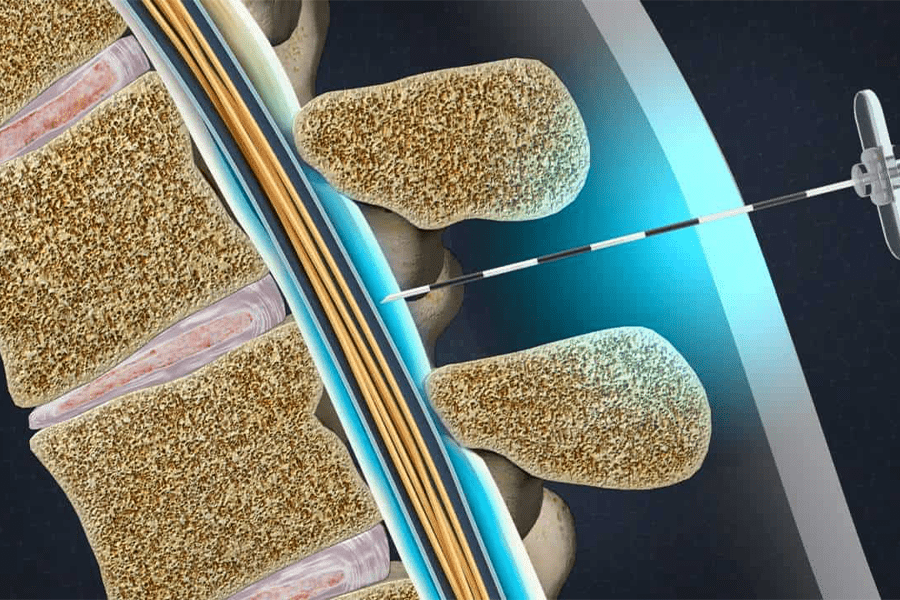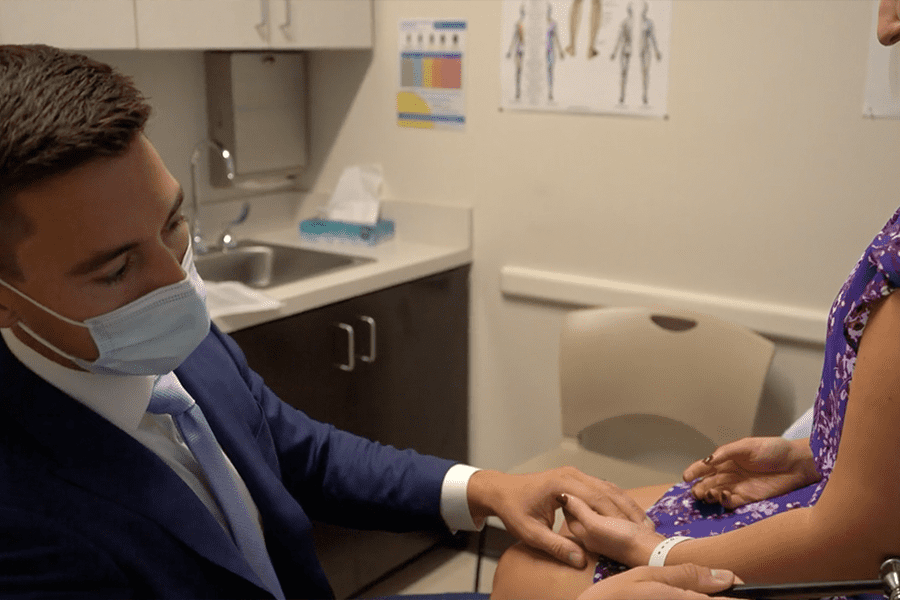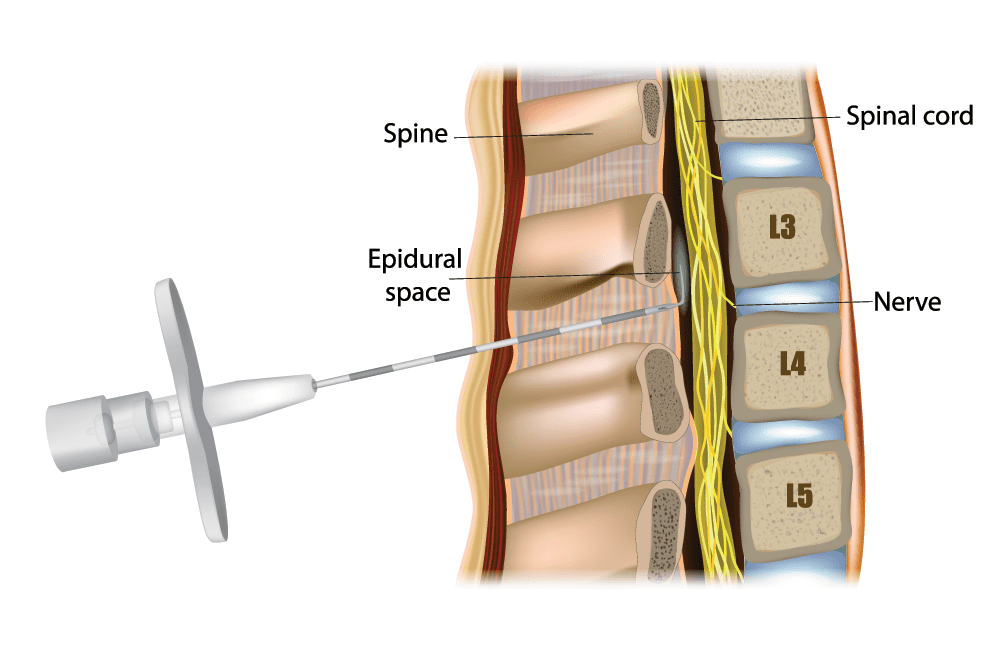What Are Lumbar Injections for Back Pain? Jan’s Patient Journey
- What is a lumbar injection?
- How can a lumbar injection help me?
- What happens during a lumbar injection?
- How long does a lumbar injection last?
Back pain is a common complaint and one of the main reasons patients see orthopaedists each year. In fact, more than 65 million Americans experience back pain regularly. For many of them, the persistent pain can be debilitating.
Orthopaedists have a variety of treatments in their pain management toolbox, from epidural steroid injections to physical therapy. Some providers even specialize in the management of long-term chronic pain in joints and the spine. For patients suffering from chronic back pain, a lumbar epidural steroid injection can often be a lifesaver.
Orlando Orthopaedic Center patient Jan S. saw Bryce T. Austell, M.D., board-certified interventional pain management specialist, for a lumbar injection to relieve her pain. Today, Jan feels much better and says, “Every which way I turned, I had a good experience here.”
What Is a Lumbar Injection?

A lumbar injection is an epidural steroid injection that releases anti-inflammatory medicine directly into the spine. A lumbar injection can alleviate:
- Muscle weakness
- Numbness
- Pain
- Tingling
To understand these injections and how they can help resolve back pain, you have to first understand how the spine works.
The spinal column is the critical connective infrastructure along your back. The bony spinal column supports your body, allowing you to walk and move freely. In most people, the spine resembles an S-shape and is composed of:
- 33 stacked vertebral bones (the spinal canal)
- Nerves within the spinal canal branch out to your extremities and connect to your brain, serving as a critical communications network between your head and the rest of the body
- Cartilage surrounds each vertebra and is a slippery connective tissue that allows these small bones to move against each other
- Intervertebral disks cushion the bones of the spine
- Soft tissues hold everything together
There are five distinct sections of the spine:
- Cervical (the neck)
- Thoracic (middle of the back)
- Lumbar (the lower back)
- Sacrum (the hip bone area)
- Coccyx (tailbone)
Although the spinal system is sturdy enough to hold you up, it is also prone to injuries and age-related degeneration, which can damage the bones and tissue.
At 51, Jan was experiencing some of the typical signs of an aging spine, causing her pain and limiting her movements. Arthritis, which is a type of inflammation, can add to the pain of a worn-out back.
The lumbar spine plays an important role in your mobility. It serves to:
- Facilitate flexion and extension, as well as bending and twisting motions
- Protect the nerves of the back and the spinal cord
- Stabilize the upper half of the body
How Can a Lumbar Injection Help Me?
 If you’re experiencing chronic pain in the lumbar section of your spine, injecting steroids or corticosteroids directly into the epidural space between the nerves can help. While the idea of a shot in your lower back may not sound appealing at first, the relief patients feel is well worth it.
If you’re experiencing chronic pain in the lumbar section of your spine, injecting steroids or corticosteroids directly into the epidural space between the nerves can help. While the idea of a shot in your lower back may not sound appealing at first, the relief patients feel is well worth it.
Jan’s experience was a good one. She says, “Dr. Austell came in and introduced himself and made me feel very comfortable. I was really impressed with his staff, their efficiency, their playfulness, and their joy. There was joy in a place where people could have been made to feel extremely anxious and nervous.”
The primary goal of a lumbar epidural steroid injection is to alleviate pain without surgery. The injection does this by calming irritated spinal nerves in the lower back. Inflammation of the nerves can be caused by everything from a spinal injury to natural aging, which can cause the cushioning between vertebrae to wear out. When the cushion is gone, the bones can press against nerve endings, causing severe pain. Doctors classify these issues as lumbar radiculopathy or lumbar radicular pain.
Lumbar radicular pain stems from the chronic inflammation of the nerve roots in the lower back and can lead to a condition known as sciatica. Sciatica is often caused when a spinal disc malfunction puts pressure on the nerve. The pressure can result in shooting pain down the sides of the hip and lower back. A lumbar injection can often help alleviate these symptoms by lowering inflammation.
What Happens During a Lumbar Injection?
 During the lumbar epidural steroid injection procedure, the doctor will carefully insert a needle into the space around your spinal cord. The epidural area is filled with blood vessels, connective tissues, and nerves. The medication the doctor injects will calm these inflamed tissues.
During the lumbar epidural steroid injection procedure, the doctor will carefully insert a needle into the space around your spinal cord. The epidural area is filled with blood vessels, connective tissues, and nerves. The medication the doctor injects will calm these inflamed tissues.
A lumbar injection can help with several types of spinal injuries and disorders, including:
- Herniated Disk
- Axial Back Pain
- Degenerative Disk Disease
- Neurogenic Claudication (spinal nerve compression)
- Osteoarthritis
- Spinal Stenosis
Lumbar epidural steroid injections are common procedures to alleviate pain and are considered safe. After having suffered for months, Jan’s experience at Orlando Orthopaedic Center was a very positive one. She says, “I didn’t encounter a negative through the entire process, from nurses to PAs to anesthesiologists, to surgical assistants—it didn’t matter. There was joy, there was laughter, there was helpfulness.”
After the lumbar injection, Jan was pain-free. However, in some cases, the chronic pain can return to your lower back if there is an underlying condition that requires further treatment.
How Long Does a Lumbar Injection Last?
The experience is different for every patient. However, on average, the lumbar injection takes effect within a week, providing pain relief that can last anywhere from several days to three months or so. Although temporary, the benefit of a lumbar injection is that it can provide you with enough relief to undergo physical therapy to treat your lower back pain. The injection may also reduce or eliminate the need for more invasive surgeries.
Jan’s experience with Dr. Austell and his team is typical for patients at Orlando Orthopaedic Center. She says, “[there was] professionalism and proficiency in everything they did that day […] I don’t know the last time I’ve been treated that graciously. I have referred Dr. Austell to a number of people.”
If you’re suffering from lower back pain, don’t hesitate to reach out to our team of orthopaedic specialists. We’re here to help.


